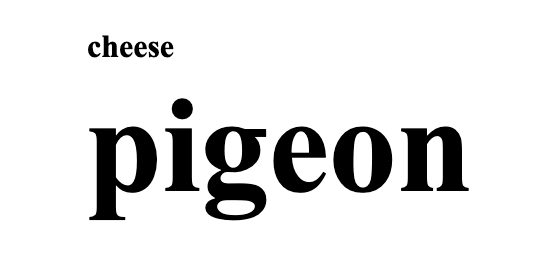By: Emma Kandel

Have you ever done your assigned reading and thought, “I’ll definitely remember this concept, it’s in huge, bold letters,” and then failed to recall anything on your quiz the next day? This feeling of disconnect between what we think we know and what we actually know can be explained by the human ability to monitor and control our own learning, also known as metacognition.
Metacognitive monitoring, or the judgement of how well you think you know something, is often studied using a rating called a judgement of learning (JOL), where participants are asked to make a prediction about their future memory performance while studying material. While it might seem like you are a relatively good judge of how much you know, researchers have found that people are actually quite often overconfident in their metacognitive monitoring as seen in their JOLs.
People tend to rely on heuristics such as familiarity (how much you have already interacted with that information) and fluency (how easy that information was to process) when making JOLs, both of which can be misleading. (Koriat, 1997). In other words, it seems that our brains can mix up “This information feels easy” with “I’ll definitely remember this later,” resulting in higher JOLs than our memory performance reflects.
For example, read the two words below:

Which word do you think you would be most likely to remember if I asked you to recall it tomorrow? Did you say pigeon? Well what if I told you that you were wrong.
The concept of believing that you know some material when you do not is called a metacognitive illusion. While accurate metacognition can allow learners to utilize study cues that are beneficial to learning, metacognitive illusions can be detrimental to performance. For instance, psychology researchers have examined how perceptual features like font size influence people’s memory predictions during learning. They found that people consistently have higher JOLs for words written in larger font sizes, even though their actual recall is unaffected by font size (Rhodes & Castel, 2008). Thus, you are not in the minority in thinking that you would remember the word pigeon over the word cheese, it was just your brain tricking you into a metacognitive illusion and an incorrect JOL.
This phenomenon, also known as the font-size effect, persists even when participants are told that font size doesn’t improve memory. Our brains are so focused on how easily the information in larger fonts is processed that we allow the ease of processing certain perceptual cues to influence our memory predictions, leading to metacognitive illusions. We are surprisingly bad at knowing what we’ll remember, and one of the most robust examples of this is seen in the font size effect. Referring back to the above example, the word pigeon is easy for us to process because it is written in enormous font, and we tend to confuse ease of processing with successful encoding. You will probably remember both pigeon and cheese once you have finished reading this blog post.
Now, you must be thinking, “Can I trust my brain at all? Do I really know anything about what I think I know?” The good news is that researchers do think that our metacognition can be trained! Even though it is true that people tend to think that they have learned something better than they actually have, if we practice considering why we think something might be easier or harder for us to remember using rules or theories about our learning, this can help us make more accurate JOLs (Koriat & Bjork, 2006).
Additionally, although the font-size effect shows wildly robust findings, researchers have found that the metacognitive illusions that come along with font size disappear when the material is related to a goal or has a given value. Value directed remembering is the process of prioritizing and remembering information deemed more valuable at the expense of less valuable information. In a 2024 study by Murphy et al., participants rated words in large fonts as more important than words in small fonts, but only when the words weren’t related to a common goal. When words in large fonts were also worth more points, people remembered them better, but when words in large fonts were worth less points, that advantage disappeared.
So, when you’re studying, rather than relying on font size to indicate importance, it could be more beneficial to sift through the information using a value scale and deciding what you absolutely must know for the exam, what is likely useful, and what is interesting but lower priority. This method might trigger value directed remembering and cause you to allocate more cognitive resources to information that is higher in value towards achieving your goal of passing your exam.
Metacognitive illusions, like the font size effect, can lead students to trust the wrong cues. Learners tend to feel confident studying bolded, highlighted notes, but just those surface features alone don’t usually strengthen memory. The font-size effect is just one example of a metacognitive illusion, but knowing our metacognitive limitations can help us choose stronger study strategies and lead to stronger memory recall. So, what does help our memory? Self testing, spaced out study sessions, flashcards, repetition, and a focus on deeper understanding of which information is important, rather than relying on just the appearance of the information.
In sum, metacognition isn’t just thinking about thinking, it’s learning how to outsmart your own overconfidences. So, the next time you’re tempted to rely on how easy some concept looks in your textbook, try to remember that bold doesn’t equal better. Challenge your memory, don’t flatter it.
References
Koriat, A. (1997). Monitoring one’s own knowledge during study: A cue-utilization approach to judgments of learning. Journal of Experimental Psychology: General, 126(4), 349–370. https://doi.org/10.1037/0096-3445.126.4.349
Koriat, A., & Bjork, R. A. (2006). Illusions of competence during study can be remedied by manipulations that enhance learners’ sensitivity to retrieval conditions at test. Memory & Cognition, 34(5), 959–972. https://doi.org/10.3758/BF03193244
Murphy, D. H., Rhodes, M. G., & Castel, A. D. (2024). The perceived importance of words in large font guides learning and selective memory. Memory & Cognition, 52(8), 1463–1476. https://doi.org/10.3758/s13421-024-01555-2
Rhodes, M. G., & Castel, A. D. (2008). Memory predictions are influenced by perceptual information: Evidence for metacognitive illusions. Journal of Experimental Psychology: General, 137(4), 615–625. https://doi.org/10.1037/a0013684